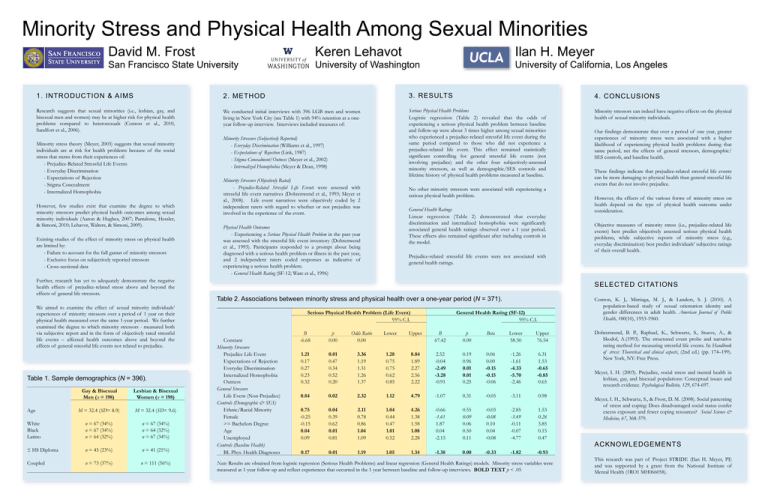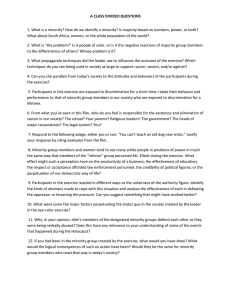
Minority Stress and Physical Health Among Sexual Minorities
!
David M. Frost
Keren Lehavot
Ilan H. Meyer
San Francisco State University
University of Washington
University of California, Los Angeles
1. INTRODUCTION & AIMS
2. METHOD
3. RESULTS
4. CONCLUSIONS
Research suggests that sexual minorities (i.e., lesbian, gay, and
bisexual men and women) may be at higher risk for physical health
problems compared to heterosexuals (Conron et al., 2010,
Sandfort et al., 2006).
We conducted initial interviews with 396 LGB men and women
living in New York City (see Table 1) with 94% retention at a oneyear follow-up interview. Interviews included measures of:
Serious Physical Health Problems
Logistic regression (Table 2) revealed that the odds of
experiencing a serious physical health problem between baseline
and follow-up were about 3 times higher among sexual minorities
who experienced a prejudice-related stressful life event during the
same period compared to those who did not experience a
prejudice-related life event. This effect remained statistically
significant controlling for general stressful life events (not
involving prejudice) and the other four subjectively-assessed
minority stressors, as well as demographic/SES controls and
lifetime history of physical health problems measured at baseline.
Minority stressors can indeed have negative effects on the physical
health of sexual minority individuals.
Minority stress theory (Meyer, 2003) suggests that sexual minority
individuals are at risk for health problems because of the social
stress that stems from their experiences of:
- Prejudice-Related Stressful Life Events
- Everyday Discrimination
- Expectations of Rejection
- Stigma Concealment
- Internalized Homophobia
However, few studies exist that examine the degree to which
minority stressors predict physical health outcomes among sexual
minority individuals (Aaron & Hughes, 2007; Pantalone, Hessler,
& Simoni, 2010; Lehavot, Walters, & Simoni, 2009).
Existing studies of the effect of minority stress on physical health
are limited by:
- Failure to account for the full gamut of minority stressors
- Exclusive focus on subjectively reported stressors
- Cross-sectional data
Further, research has yet to adequately demonstrate the negative
health effects of prejudice-related stress above and beyond the
effects of general life stressors.
We aimed to examine the effect of sexual minority individuals’
experiences of minority stressors over a period of 1 year on their
physical health measured over the same 1-year period. We further
examined the degree to which minority stressors - measured both
via subjective report and in the form of objectively rated stressful
life events – affected health outcomes above and beyond the
effects of general stressful life events not related to prejudice.
Table 1. Sample demographics (N = 396).
Age
White
Black
Latino
≤ HS Diploma
Coupled
Gay & Bisexual
Men (n = 198)
M = 32.4 (SD= 8.9)
n = 67 (34%)
n = 67 (34%)
n = 64 (32%)
n = 45 (23%)
n = 73 (37%)
Lesbian & Bisexual
Women (n = 198)
M = 32.4 (SD= 9.6)
n = 67 (34%)
n = 64 (32%)
n = 67 (34%)
n = 41 (21%)
n = 111 (56%)
Minority Stressors (Subjectively Reported)
- Everyday Discrimination (Williams et al., 1997)
- Expectations of Rejection (Link, 1987)
- Stigma Concealment/Outness (Meyer et al., 2002)
- Internalized Homophobia (Meyer & Dean, 1998)
Minority Stressors (Objectively Rated)
- Prejudice-Related Stressful Life Events were assessed with
stressful life event narratives (Dohrenwend et al., 1993; Meyer et
al., 2008). Life event narratives were objectively coded by 2
independent raters with regard to whether or not prejudice was
involved in the experience of the event.
Our findings demonstrate that over a period of one year, greater
experiences of minority stress were associated with a higher
likelihood of experiencing physical health problems during that
same period, net the effects of general stressors, demographic/
SES controls, and baseline health.
These findings indicate that prejudice-related stressful life events
can be more damaging to physical health than general stressful life
events that do not involve prejudice.
No other minority stressors were associated with experiencing a
serious physical health problem.
However, the effects of the various forms of minority stress on
health depend on the type of physical health outcome under
consideration.
General Health Ratings
Linear regression (Table 2) demonstrated that everyday
discrimination and internalized homophobia were significantly
associated general health ratings observed over a 1 year period.
These effects also remained significant after including controls in
the model.
Physical Health Outcomes
- Experiencing a Serious Physical Health Problem in the past year
was assessed with the stressful life event inventory (Dohrenwend
et al., 1993). Participants responded to a prompt about being
diagnosed with a serious health problem or illness in the past year,
and 2 independent raters coded responses as indicative of
experiencing a serious health problem.
- General Health Rating (SF-12; Ware et al., 1996)
Objective measures of minority stress (i.e., prejudice-related life
events) best predict objectively assessed serious physical health
problems, while subjective reports of minority stress (e.g.,
everyday discrimination) best predict individuals’ subjective ratings
of their overall health.
Prejudice-related stressful life events were not associated with
general health ratings.
SELECTED CITATIONS
Table 2. Associations between minority stress and physical health over a one-year period (N = 371).
Serious Physical Health Problem (Life Event)
95% C.I.
Constant
Minority Stressors
Prejudice Life Event
Expectations of Rejection
Everyday Discrimination
Internalized Homophobia
Outness
General Stressors
Life Event (Non-Prejudice)
Controls (Demographic & SES)
Ethnic/Racial Minority
Female
>= Bachelors Degree
Age
Unemployed
Controls (Baseline Health)
BL Phys. Health Diagnoses
General Health Rating (SF-12)
95% C.I.
B
-6.68
p
0.00
Odds Ratio
0.00
Lower
Upper
B
67.42
p
0.00
Beta
Lower
58.30
Upper
76.54
1.21
0.17
0.27
0.23
0.32
0.01
0.47
0.34
0.52
0.20
3.36
1.19
1.31
1.26
1.37
1.28
0.75
0.75
0.62
0.85
8.84
1.89
2.27
2.56
2.22
2.52
-0.04
-2.49
-3.28
-0.91
0.19
0.96
0.01
0.01
0.25
0.06
0.00
-0.15
-0.15
-0.06
-1.26
-1.61
-4.33
-5.70
-2.46
6.31
1.53
-0.65
-0.85
0.65
0.84
0.02
2.32
1.12
4.79
-1.07
0.31
-0.05
-3.11
0.98
0.75
-0.25
-0.15
0.04
0.09
0.04
0.39
0.62
0.01
0.81
2.11
0.78
0.86
1.04
1.09
1.04
0.44
0.47
1.01
0.52
4.26
1.38
1.58
1.08
2.28
-0.66
-1.61
1.87
0.04
-2.15
0.55
0.09
0.06
0.50
0.11
-0.03
-0.08
0.10
0.04
-0.08
-2.85
-3.49
-0.11
-0.07
-4.77
1.53
0.26
3.85
0.15
0.47
0.17
0.01
1.19
1.05
1.34
-1.38
0.00
-0.33
-1.82
-0.93
Note: Results are obtained from logistic regression (Serious Health Problems) and linear regression (General Health Ratings) models. Minority stress variables were
measured at 1-year follow-up and reflect experiences that occurred in the 1 year between baseline and follow-up interviews. BOLD TEXT p < .05
Conron, K. J., Mimiaga, M. J., & Landers, S. J. (2010). A
population-based study of sexual orientation identity and
gender differences in adult health. American Journal of Public
Health, 100(10), 1953-1960.
Dohrenwend, B. P., Raphael, K., Schwartz, S., Stueve, A., &
Skodol, A.(1993). The structured event probe and narrative
rating method for measuring stressful life events. In Handbook
of stress: Theoretical and clinical aspects, (2nd ed.) (pp. 174–199).
New York, NY: Free Press.
Meyer, I. H. (2003). Prejudice, social stress and mental health in
lesbian, gay, and bisexual populations: Conceptual issues and
research evidence. Psychological Bulletin, 129, 674-697.
Meyer, I. H., Schwartz, S., & Frost, D. M. (2008). Social patterning
of stress and coping: Does disadvantaged social status confer
excess exposure and fewer coping resources? Social Science &
Medicine, 67, 368-379.
ACKNOWLEDGEMENTS
This research was part of Project STRIDE (Ilan H. Meyer, PI)
and was supported by a grant from the National Institute of
Mental Health (1RO1 MH066058).






